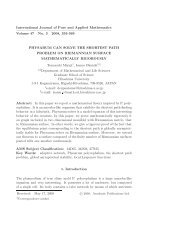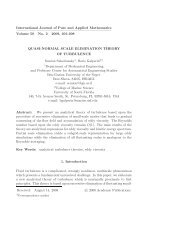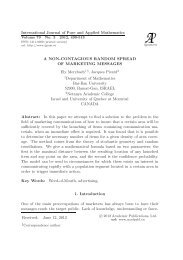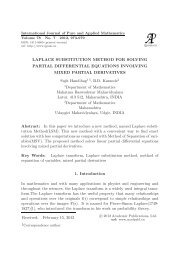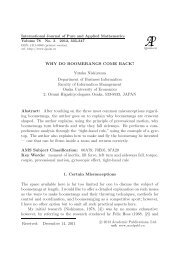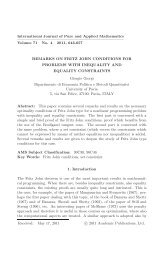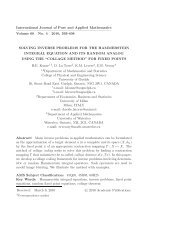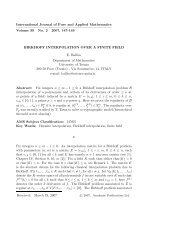CAVITATION, INDENTATION AND PENETRATION
CAVITATION, INDENTATION AND PENETRATION
CAVITATION, INDENTATION AND PENETRATION
You also want an ePaper? Increase the reach of your titles
YUMPU automatically turns print PDFs into web optimized ePapers that Google loves.
362 D. Durban, R. Masri<br />
cylindrical cavity (Mises)<br />
pc = 1<br />
√ 3 Y<br />
√ <br />
3E<br />
1 + ln , (2)<br />
(5 − 4ν)Y<br />
cylindrical cavity (Tresca)<br />
pc = 1<br />
2 Y<br />
<br />
<br />
2E<br />
1 + ln . (3)<br />
(5 − 4ν)Y<br />
Here, Y is the yield stress, E – elastic modulus, ν – Poisson ratio. For a<br />
pressurized spherical cavity both Mises and Tresca yield conditions coincide<br />
due to spherical symmetry of the stress field. However, they differ in planestrain<br />
axially-symmetric fields implying the difference between (2) and (3).<br />
Cavitation pressure serves as an extreme measure of strength of elastoplastic<br />
solids. The dynamic version of pc has been successfully applied to impact<br />
penetration, Masri[9], in the spirit of the methodology suggested by Goodier[5].<br />
A detailed review of earlier work on dynamic cavitation by Hopkins[7] concentrates<br />
on incompressible elastic/perfectly-plastic material. An elegant expres-<br />
sion due to Hill is available for spherical cavities, namely,<br />
Pc = pc<br />
E<br />
= 2<br />
3 Σy<br />
<br />
1 + ln 2<br />
3Σy<br />
<br />
+ 3<br />
2 m2 , (4)<br />
where Σy = Y/E and m = ˙ A/ E/ρ0, ˙ A is the cavity expansion velocity and<br />
ρ0 the density.<br />
A possible analogue of (4) for plane-strain cylindrical dynamic cavitation in<br />
incompressible Mises solids has been given recently by Masri and Durban[11]<br />
in the form<br />
Pc = Σy<br />
<br />
Σy<br />
√3 +<br />
√3 + m2<br />
2<br />
<br />
ln<br />
1<br />
√ 3Σy + 3<br />
2 m2<br />
<br />
. (5)<br />
This solution however is not perfect as small stresses are required in the far<br />
field to sustain the expansion process.<br />
2. Indentation<br />
Both experimental data, Johnson[8], and numerical analysis, Casalas and Alcala[2],<br />
indicate the existence of a spherical cavity expansion field beneath rigid axisymmetric<br />
indenters (Figure 1).<br />
The general result for quasi-static spherical cavitation pressure, Durban and



